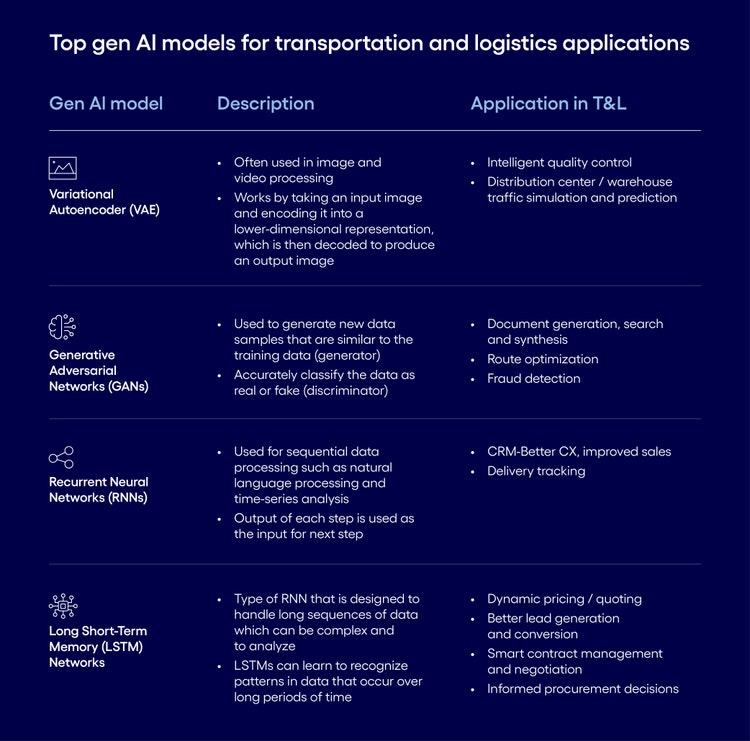
Gen AI in transportation and logistics : five principles
<p><br> <span class="small">July 03, 2024</span></p>
Gen AI in transportation and logistics: five principles
<p><b>In this sector, it’s especially important to zero in on high-feasibility projects that can deliver results quickly.</b></p>
<p>There are few industries facing as many conflicting demands as transportation and logistics. Leaders in this sector are striving to advance efficiency, reduce costs, and keep up with growing visibility and personalization expectations (the “Amazon effect”)—all while managing acute market fluctuations, labor shortages, and sustainability initiatives.</p> <p>Generative AI in transportation and logistics offers promising solutions to address these challenges. It has the potential to serve as a co-pilot with which operations and customer service organizations can drive productivity while reducing the cost of errors, and its ease of use can reduce friction in an industry that historically lags in technology modernization.</p> <h4>Where gen AI meets transportation and logistics</h4> <p>An <a href="https://www.idc.com/getdoc.jsp?containerId=US50757424" target="_blank" rel="noopener noreferrer">IDC survey found that more than 50% of transportation and logistics firms</a> are already implementing gen AI, with about 70% of use cases being in knowledge management, marketing (better shipper/lead conversion, enhanced dynamic pricing/quoting), and product/service design.</p> <p>Further, according to a <a href="https://www.precedenceresearch.com/artificial-intelligence-market" target="_blank" rel="noopener noreferrer">Precedence Research report</a>, the market is set to grow at an annual rate of 44% to $19 billion by 2032. Transportation and logistics will be an ongoing contributor to that growth due to gen AI’s ability to help address changing consumer behavior, cost pressures, labor shortages, and disruption from geopolitical conflict, legislation, and even black swan events.</p> <p>The top AI models that address these use cases (as well as wide-ranging applications across the value chain) are shown in Figure 1.</p>

#
<p><span class="small">Figure 1</span></p> <p>Industry leaders have already invested in use cases around customer experience, transportation execution, and contract advisory as immediate value generators. This is just the beginning. We believe that if implemented wisely, gen AI in transportation and logistics will benefit every link in the value chain with its conversational, referential, and creative capabilities.</p> <h4>The intersection of maximum impact: feasibility + value</h4> <p>After discussions with transportation and logistics leaders, and after helping clients with pilot programs, we’ve identified high-feasibility, high-value use cases in which businesses in the sector should apply generative AI. We classify these use cases into four categories, as shown in Figure 2: customer experience, transportation planning and execution, contract advisory, and content generation.</p>

#
<p><span class="small">Figure 2</span><br> <br> This is only a high-level look at potential applications. The use cases in Figure 2 all have their own strong set of sub-categories for possible implementations. This is where each transportation and logistics company must marry pilot use cases with its own vision, goals, and differentiators.</p> <p>Regardless of where a company begins, generative AI’s overwhelming potential stems from its ability to not only improve planning and execution but to also make life more predictable, less stressful, and even safer for the billions who rely on the goods transported. Medicine, food, and materials that underpin the fabric of our society are at stake, giving “responsible AI” a dual meaning in the transportation and logistics sector.</p> <h4>Five guiding principles for deploying gen AI in transportation and logistics</h4> <p>Even companies that have use cases in mind may find that creating buy-in, putting the wheels in motion, and scaling are significant challenges. We suggest that transportation and logistics leaders follow these guiding principles in early gen AI deployment to maximize success.</p> <ol> <li><b> Explore. </b>Identify the pros and cons of gen AI concepts for your organization. Consider the potential across the full sector value chain and current market trends.<br> <br> </li> <li><b> Plan. </b>Prioritize high-potential use cases by using a framework for decision-making<b>, </b>analyzing deeper cost-benefit scenarios, and<b> </b>assessing the readiness of your data, skills and people.<br> <br> </li> <li><b> Pilot. </b>Define the appropriate solution architecture and the right gen Al model for your use case.<b> </b>Identify data sources and process data and determine your implementation roadmap<b>. </b>Deploy and assess value realized.<br> <br> </li> <li><b> Scale. </b>Extend system integrations and<b> </b>continually monitor results.<b> </b>Research new gen Al models to address your pain points and prioritize additional high-value use cases.<br> <br> </li> <li><b> Innovate. </b>Conduct periodic reviews of use cases, prioritization, technology, adoption, and user feedback.</li> </ol> <h4>Ground Zero: build your ecosystem</h4> <p>It is critical that transportation and logistics leaders select the right partner as they embark on their generative AI journey. Any organization they partner with should bring insights gleaned from other companies in the sector and third-party data sources.</p> <p>Keeping in mind how critical Gen AI will be, Cognizant has invested in a <a href="https://www.cognizant.com/us/en/services/neuro-intelligent-automation/neuro-generative-ai-adoption" target="_blank" rel="noopener noreferrer">Neuro AI platform</a> that brings together multiple features spanning areas such as IT services, automation and Gen AI, spearheading proof of concepts for multiple clients.<br> </p>
<p>We’re here to offer you practical and unique solutions to today’s most pressing technology challenges. Across industries and markets, get inspired today for success tomorrow.</p>

